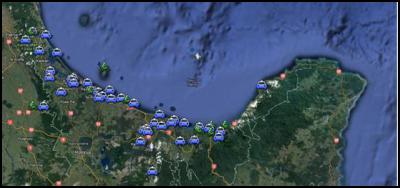Bay of Plenty Crash Hotspot Identified
17 January 2013
Bay of Plenty
Crash Hotspot Identified
Trauma is a major health burden in New Zealand, as it is around the world. Approximately 2500 New Zealanders die per year as a result of trauma and approximately 25,000 require hospital care for their injuries. Trauma is the leading cause of death between the ages of 5 to 45.
A major cause of trauma injuries in the BOP community is from road crashes. Although the number and rate of road deaths have decreased internationally, they remain a major public health burden.
As part of a Ministry of Health supported initiative, the Bay of Plenty District Health Board, in conjunction with other agencies and other District Health Boards, has established a trauma review team. The team is tasked with assessing the effectiveness of our trauma systems in saving and salvaging lives and in improving this system.
One of the questions being looked at, by the trauma review team, is where and when road traffic injuries occur and can we do anything about preventing these. The Road Safety Committee with representation from police, St Johns, and the council also monitor this. The New Zealand Transport Agency also use a Crash Analysis System (CAS) to log all reported road crashes throughout the country and monitor problem areas.
The trauma team at the Bay of Plenty District Health Board has identified the contributing factors of 64 separate road crashes that happened in the region over an 11 month period (1 January 2012 to 30 November 2012) that resulted in a hospital stay in excess of 24 hours for the driver or passengers.
“We found that driver error remained a significant cause of most crashes from which people were admitted to hospital, while roading and weather conditions accounted for a very small percentage of the crashes,” said Bay of Plenty District Health Board’s Chief Operating Officer, Phillip Balmer.
Mr Balmer said road crashes involving drivers that were under the influence of alcohol or illicit substances were excluded from the review and if included would have trebled our figures. It also excluded crashes which resulted in hospital admissions of less than 24 hours duration.
“Our findings showed that driver error combined with excessive speed on open roads were the most common factors contributing towards Bay of Plenty road crashes. Drivers’ errors included the driver falling asleep at the wheel, excessive speed, inexperience, crossing the centre line, swerving to avoid objects and pulling out in traffic.”
“While the crashes happened relatively evenly throughout the Bay of Plenty region, they were mainly on the major state highways.”
“The review identified the regions’ crash hot spot at the intersection of State Highways 2 and 33 at Paengaroa. Of the five crashes at this site, four were head on collisions, resulting in multiple victims from each crash coming into hospital,” he said.
“The urban areas of Whakatane and Tauranga accounted for two and four crashes respectively causing patients to be admitted to hospital for more than 24 hours. The review suggests that urban road traffic crashes did not result in significant injuries due to low vehicle speed.”
There were nine separate motorcyclist crashes, four of which occurred around the Opotiki district.
Mr Balmer said there was no common cause for the motorcyclist crashes as the causes ranged from sun-strike, being hit by a truck, losing control and excessive speed.
Notably most of the crashes that resulted in hospital admissions of greater than 24 hours occurred between 1200-2200 hrs. Crash numbers peaked at the high traffic periods - that is between 1200-1300 hours, then 1600-1800 hours and 0700-0900 hours. Surprisingly, there were only 4 crashes from 2200-0700 hours.
The information for the review was taken from St John Ambulance records, the Midland DHB’s Regional Trauma System data sheets, ACC forms, hospital web based patient administration systems, and from patients themselves.
Summary of crashes and causes shown in the map below:
• 64 separate road
crashes.
• 41 crashes could be contributed to driver
error (driver falling asleep at the wheel, excessive speed
[more than 100kmh], inexperience, crossing the centre line,
swerving to avoid objects and pulling out in
traffic.
• 11 crashes due to impact with objects
(animals, people and stationary object).
• 8 crashes
consequence of weather conditions.
• 4 crashes from
road conditions such as loose gravel and pot
holes.

Bay of Plenty moving vehicle crashes 2012
This map plots all moving vehicle crashes within the BOP that fits the inclusion/exclusion criteria:
Exclusion - driver under the influence of alcohol/illicit drugs - hospital admission <24 hours.
Inclusion - crash must have involved a moving vehicle - crash must have occurred within the BOP region between timeframe of January 1st 2012 to October 30, 2012.
ENDS


 Gordon Campbell: On The Left’s Electability Crisis, And The Abundance Ecotopia
Gordon Campbell: On The Left’s Electability Crisis, And The Abundance Ecotopia NZ Police: New Zealand Police team up with Z Energy, NZTA and ACC to remind Kiwis to drive safe this Easter
NZ Police: New Zealand Police team up with Z Energy, NZTA and ACC to remind Kiwis to drive safe this Easter NZCAST: NZCAST Leads Ongoing Cross-Agency Collaboration To Break Down Barriers For Survivors Of State Abuse
NZCAST: NZCAST Leads Ongoing Cross-Agency Collaboration To Break Down Barriers For Survivors Of State Abuse Regional and Unitary Councils Aotearoa: Regional And Unitary Councils Back A Practical FWFP System
Regional and Unitary Councils Aotearoa: Regional And Unitary Councils Back A Practical FWFP System NZ Government: Stay Safe On Our Roads This Easter
NZ Government: Stay Safe On Our Roads This Easter YWCA: Global Push Back Against Gender Equality A Growing Crisis In Aotearoa
YWCA: Global Push Back Against Gender Equality A Growing Crisis In Aotearoa Te Pāti Māori: Ngarewa-Packer - Fast-Tracking Seabed Mining Ignores Māori Opposition And Environmental Precedent
Te Pāti Māori: Ngarewa-Packer - Fast-Tracking Seabed Mining Ignores Māori Opposition And Environmental Precedent


